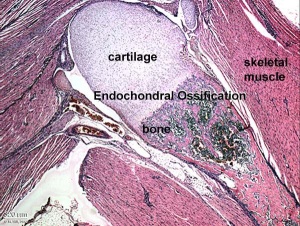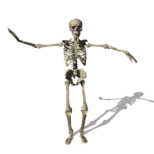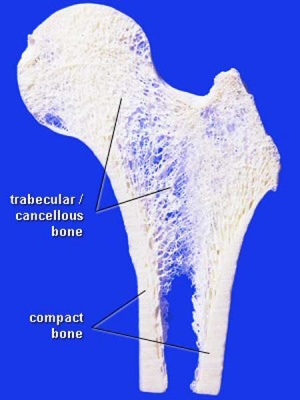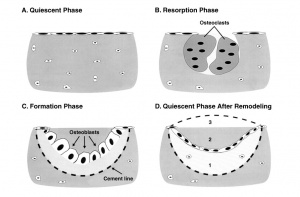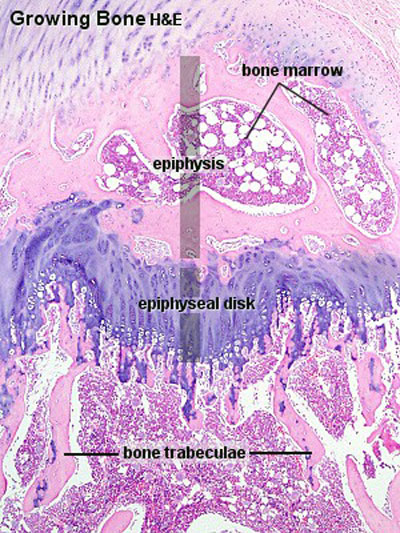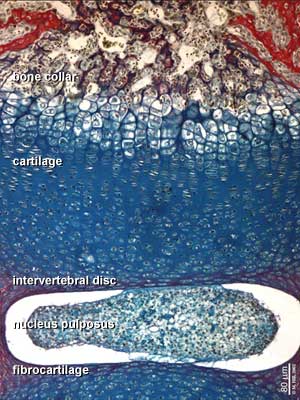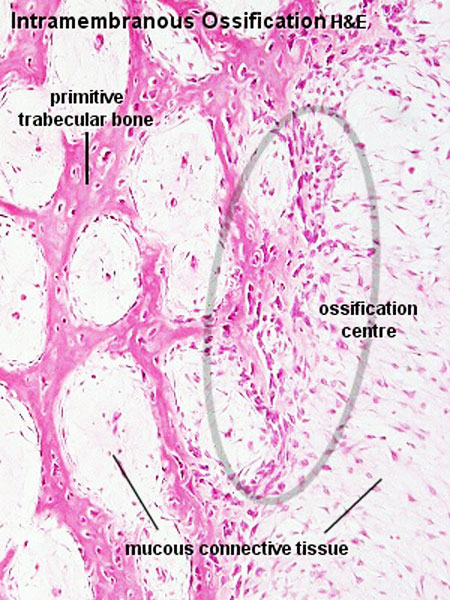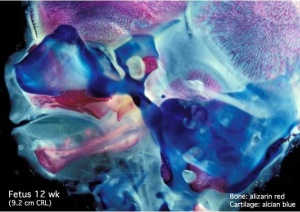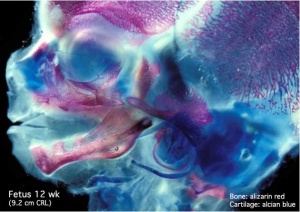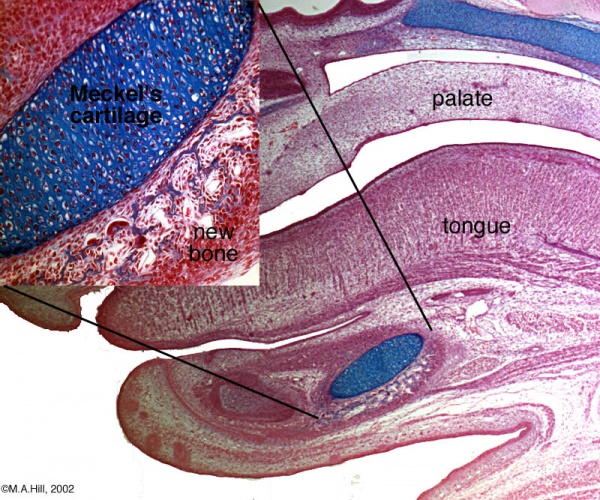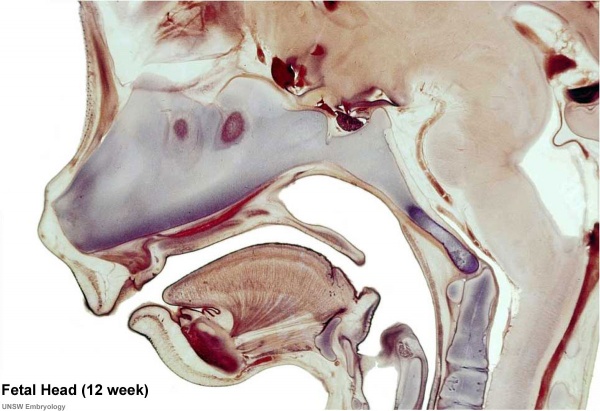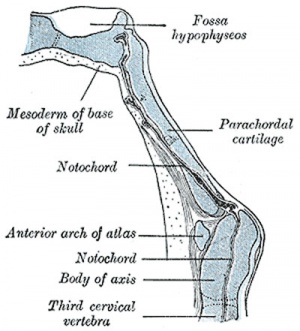Bone Development
Introduction
Our adult skeleton forms from a larger number of developmental elements that are replaced and fuse. In development there are 2 separate signaling pathways for pattern formation and the formation of bone itself. Furthermore bone formation can be divided into 2 specific forms that occur in anatomically different regions. This practical class will describe the development and structure of bone and finish with a study of abnormalities associated with bone.
The image shown to the left shows a histological section through the developing lower limb at the level of a developing joint (knee), surrounding the developing bone are skeletal muscles and connective tissue of the limb.
Note: This current page contains both additional information and images to the practical class set. These are provided for educational information and study purposes only.
For more development background see the Science Lecture - Musculoskeletal Development
Objectives
- Understand the general microanatomy of bone
- Understand bone cell types (location, structure, function)
- Understand the histology of compact and spongy bone
- Understand the 2 forms of developmental bone formation
Textbook
Histology and Cell Biology: An Introduction to Pathology, A.L. Kierszenbaum, 2002 - Connective Tissue, Chapter 4 pp118-129; Osteogenesis, Chapter 5 pp131-145
Slides
UNSW Virtual Slidebox Virtual Slidebox Phase 1
- Compact Bone - Adult Bone , Adult (Ground, TS) Human Alizarin Red | Bone (Ground, LS) Human Alizarin Red
- Compact Bone Rib Decalcified rib, bone marrow
- Endochondral ossification Developing bone | Bone, Developing (LS, Femur) Cat H&E
- Intramembranous ossification Head (Neonatal) Rat H& Van Gieson
Bone Structure
Compact bone
- no spaces or hollows in the bone matrix visible to the eye.
- forms the thick-walled tube of the shaft (or diaphysis) of long bones, which surrounds the marrow cavity (or medullary cavity). A thin layer of compact bone also covers the epiphyses of long bones.
Trabecular bone
- (cancellous or spongy bone) consists of delicate bars (spicules) and sheets of bone, trabeculae
- branch and intersect to form a sponge-like network
- ends of long bones (or epiphyses) consist mainly of trabecular bone.
Periosteum
Connective tissue covering the surface of bone (except articular surfaces).
Endosteum
Connective tissue lining inner surface of bone.
Bone Growth
- Appositional growth occurs at either the periosteum (outer surface), or the endosteum (inner surface).
- Osteoblasts secrete osteoid, a pre-bone material composed mainly of type I collagen that becomes mineralized.
- In development, there are 2 distinct types of bone formation (intramembranous and endochondral)
Bone Cells
Osteoblasts
- derive from osteogenic stem cells the osteoprogenitor cells that differentiate to form pre-osteoblast then osteoblasts maturing to an osteocyte
- osteoprogenitor cells - line the inner and outer surfaces of bone
Osteocytes
- mature bone-forming cells embedded in bone matrix
- osteoblasts and osteocytes - secrete organic matrix of bone (osteoid), converted into osteocytes when become embedded in matrix (which calcifies soon after deposition)
Osteoclasts
- bone-resorbing multinucleated macrophage-like cells
- origin- fusion of monocytes or macrophages, Blood macrophage precursor, Attach to bone matrix
- seal a small segment of extracellular space (between plasma membrane and bone surface), HCl secreted into this space by osteoclasts dissolves calcium phosphate crystals (give bone rigidity and strength) (Google- osteoclast images)
- do not mistake for megakaryocytes, found in bone marrow not associated with bone matrix.
- megakaryocytes are also multi-niucleated and form platelets
Chondroblasts and Chondrocytes
- immature and mature cartilage forming cells located at articular cartilage regions.
- Interstitial growth - occurs mainly in immature cartilage. Chondroblasts in existing cartilage divide and form small groups of cells (isogenous groups) which produce matrix to become separated from each other by a thin partition of matrix.
- Appositional growth - occurs also in mature cartilage. Mesenchymal cells surrounding the cartilage in the deep part of the perichondrium (or the chondrogenic layer) differentiate into chondroblasts.
Bone Matrix
The bone matrix has 2 major components. Organic portion composed of mainly collagen Type 1 (about 95%) and amorphous ground substance. Inorganic portion (50% dry weight of the matrix) composed of hydroxyapatite crystals, calcium, phosphorus, bicarbonate, nitrate, Mg, K, Na. (Google- bone matrix images)
Haversian Systems
- also called osteons
- Volkmann's canals - interconnect Haversian systems
Lamellae
- concentric - surrounding each Haversian System
- interstitial - bony plates that fill in between the haversian systems.
- circumferential - layers of bone that underlie the periosteum and endosteum
Cells
- osteocytes extending cytoplasmic processes into canaliculi
- Additional Histology images: low | medium | high
Endochondral ossification
Endochondral ossification slides Developing bone | Bone, Developing (LS, Femur) Cat H&E
Additional Histology Slides: developini Vertebra | Vertebra medium
Intramembranous ossification
Intramembranous ossification Head (Neonatal) Rat H& Van Gieson
Human Fetal Head (12 week)
Histology Stains
Alizarin Red
- an anthraquinone derivative used to identify calcium in tissue sections
- calcium forms an Alizarin Red S-calcium complex in a chelation process and the end product is also birefringent.
- reaction can also identify magnesium, manganese, barium, strontium, and iron may interfere
- these elements usually in too low concentration to interfere with the staining
H&E
- acronym for hematoxylin and eosin stain
- hematoxylin - basic dye which colors basophilic structures with blue-purple hue (nucleus, DNA, RNA)
- eosin Y - acidic alcohol-based which colors eosinophilic structures bright pink (cytoplasm, extracellular matrix, protein)
H&Van Gieson
- Van Gieson's Stain is a mixture of picric acid and acid fuchsin used for differential staining of collagen and other connective tissue.
- Nuclei - stains brownish black to black
- Collagen (fibrous connective tissue) - stains pink or deep red
- Muscle, Cytoplasm, RBC and Fibrin - stains yellow
Links
- UNSW Embryology Additional Cartilage and Bone Histology slides
- Original class notes
- UNSW Virtual Slidebox Virtual Slidebox Phase 1
- Virtual Slidebox of Histology (USA) Skeletal system
- Lecture - Musculoskeletal Development
- e-radiography Ossification
Other Textbooks
- Anatomy of the Human Body (H. Gray, 1918.) historical anatomy text Osteology
- Molecular Biology of the Cell Bone Is Continually Remodeled by the Cells Within It | Image: Figure 22-52. Deposition of bone matrix by osteoblasts | Image: Figure 22-56. The development of a long bone
- Molecular Cell Biology Mutations in Collagen Reveal Aspects of Its Structure and Biosynthesis
- The Cell- A Molecular Approach Steroid Hormones and the Steroid Receptor Superfamily
- Clinical Methods: The History, Physical, and Laboratory Examinations 100. Alkaline Phosphatase and Gamma Glutamyltransferase
- Endocrinology: An Integrated Approach by Nussey, S.S. and Whitehead, S.A. Endocrinology: Definition and causes of osteoporosis
- Developmental Biology 6th ed. by Gilbert, Scott F. Aging: The Biology of Senescence
